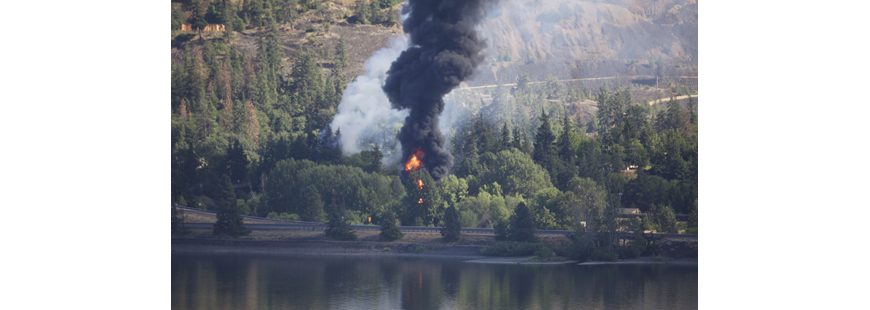Fire from an oil train derailment in Mosier, Oregon. Photo by Michael O’ Leary.
I know, no-brainer, right?
It’s been a busy week, and couple of months for that matter, here in the Pacific Northwest. It seems, despite domestic and world-wide market demand, coal and oil corporations are looking to the Pacific Northwest to export our domestically extracted fossil fuels to send overseas. Well, we’ve been telling them that oil and coal don’t mix AT ALL, with water. And we’ve got several instances where we can prove it.
I’m not sure why this conversation ever got started, but it seems one of Congress’s “compromises” for funding (at 50% of its intended level) the Land and Water Conservation Fund was to lift the ban on domestic oil exports. It seems our new energy independence has become somewhat of a boon to the oil industry. Who’s all for shrinking the trade deficit anyway? I certainly am, but at what cost? That’s the question we have to ask ourselves.
Given the recent events at Mosier, Oregon earlier this month, most would agree, our river and salmon fishery resources are too valuable to risk for the return to our domestic benefit. And that’s just talking about oil. Even of greater bigger-picture value is what coal consumption is doing to our land and water ecosystems. To start, scientific evidence, and mathematical too, are telling us that the massive 100-car trains that roar down the Columbia River on a daily basis are losing 1-pound of coal dust per mile, per rail car for the 150 mile trek down the Columbia River. Take that into account, for the 150-mile trek down the Columbia River and guess how much of that is ending up in our river systems. Due to the volatility of this product, they can’t cover it; it could easily catch fire under the conditions for which it travels. Ever hear of underground coal fires? Yeah, it happens, more than we care to know. Some coal fires have been happening for just 5 decades, one that we know about, for 6,000 years. A lightning strike could set one off, and they’re nearly impossible to extinguish.
But that may be the least of our worries on coal. You’ve possibly read my blog posts on ocean acidification and the fact scientists are stating that we’re just seeing the effects of CO2 emissions from 30 years ago; the worst is yet to come, and that’s if we level off our emissions right now.
We’re setting ourselves up for a battle for what everyone has to agree is our world’s most valuable resource: fresh, clean water. Nothing on earth can survive without it and everyone on earth knows that it exists in finite amounts. The more fresh water we have, the more plant, animal and of course, fish life we have.
What the federal government is doing right now is calculating the true cost of coal, especially coal that’s coming off OUR public lands. Through the Programmatic Environmental Impact Statement (PEIS) comment period, the Bureau of Land Management (BLM) is evaluating the federal coal leasing program on public lands. It’s been over 30 years since we’ve taken a comprehensive look at this program that benefits the slowly bankrupting coal conglomerates, while choking out our ecosystems.
I testified in Seattle on June 21st; there’s so much low-hanging fruit here. Taking into account the multi-million dollar oyster, crab and shrimp fisheries, not to mention the billion dollar salmon fisheries these decisions have an impact on, and there’s the history these coal companies have in regards to the failed reclamation of the lands where this activity has taken place. Reliable reports indicate that a paltry 10% of mined lands have been reclaimed after extractive activity… you read that right… 10%. And yes, wildlife bears the greatest burden of this crime against nature.
Although we may not agree with proponents of the coal industry, if there is one thing that the conservation community AND the coal miners do agree on, is that industry workers should not be left out in the cold when this full transition takes place, and, it is going to take place. Like most sensible solutions, the citizens of our states will demand that we systematically remove coal from our energy portfolios. I’m proud to say that Oregon has taken a leadership position on this issue, phasing out coal on our power grid by 2030 and requiring that 50% of our state’s power come from renewable resources (not sure that should include hydropower, however…).
As I look out my window, gazing at the intermittent downpours we’ve experienced today, it’s refreshing that we have so much fresh water in Oregon. Of course it wasn’t that way last year. Our lands were parched, and our salmon were turning belly up about this time a year ago. Take a look at the fish counts at Bonneville Dam and revel in the return of the salmon. Sockeye seem to be coming in stronger than predicted, a welcome sign that the once barren Redfish Lakewill once again kinda teem with sockeye salmon if the warm waters of Eastern Oregon and Idaho don’t kill off half the run, like what happened last year. Let’s not throw our greatest resource under the bus; clean, cold, abundant water is our future. We need to do what we can to protect it, so let’s pay attention.


